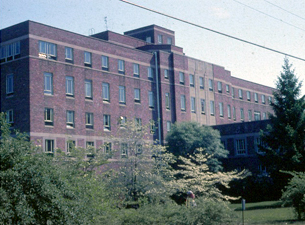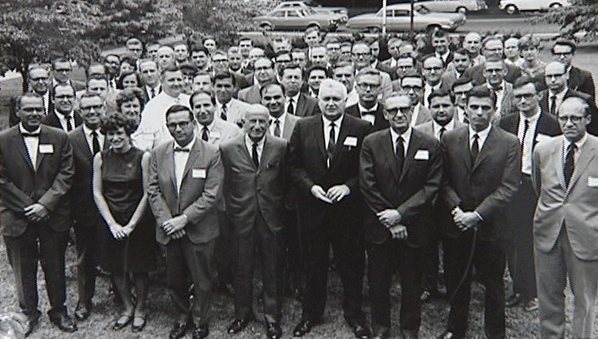Feature Story
Health Center Today, March 29, 2011
An Opportunity to Do Wonderful Things
By Noreen Kirk

McCook Hospital.
This story is the third of a multi-part series on the history of the Health Center. The entire series can be read at the Health Center’s 50th Anniversary website.
The people involved in the Health Center’s early years recall the excitement they felt in being part of creating something new and the vision and commitment they shared.
Dr. Eugene Sigman, then a tenured professor at the University of Buffalo, was recruited to the School of Medicine in 1966. “I came here and spent a lot of time interviewing with people to get a sense of the institution. After three or four visits, I realized that everyone was singing from the same page. There was a lot of enthusiasm. Everyone felt that here was an opportunity to do it right, right from the beginning.”
When he assumed his new position in 1967, the new facilities were years away from completion, and people were scattered at various sites, many at the formerly city-owned McCook Hospital in Hartford’s North End. Still, Sigman says, “Everybody pitched in. Everybody tried to enhance the institution. This was a new medical school. This was an opportunity to do wonderful things.”
Dr. Carl “Fritz” Hinz Jr., who would go on to become associate dean of the School of Medicine, also came to the medical school in 1967. His role was to establish the undergraduate curriculum. Dr. Hinz, like Drs. Patterson and Cooperstein, had been at Western Reserve (now Case-Western) University School of Medicine. In the 1950s, that university had pioneered a new, interdisciplinary model of medical education that was the first major innovation in the field since 1910. When offered the opportunity to join the fledgling Connecticut school, Dr. Hinz was elated.
“I had dreamed about being involved in the creation of a new medical school, of transporting the Reserve vision to a new school,” Hinz says. “The whole thing was such a remarkable adventure.”
Pharmacologist Dr. Achilles Pappano, now professor emeritus at the medical school, was 28 years old when he joined the faculty in 1968. “There was a lot of excitement among all the people I met, all the faculty members, about making this thing a success,” Dr. Pappano recalls. “It was a really wonderful feeling. Older people and young alike shared the same spirit. It can only happen when you start something new. You dream, and you think you can make your dream come true. I can’t describe how much fun it was.”
Irene Engel, ,joined the Health Center in 1968, nine months after the first classes were admitted and while clinical activities were housed at McCook. Engel’s role was to set up the surgical and intensive care units at McCook, then prepare the new University hospital to accept patients once construction was completed.
“It was all new, and we were all feeling our way as we went,” Engel says. “It’s interesting to be in the forefront of doing something that’s brand-new. Setting up the medical and dental schools and the hospital was a challenge, and it was one that was met by a lot of wonderful people.”
Jeanne Lattanzio, who came to UConn in 1971, remembers everyone pitching in during the transition from McCook to the Farmington hospital prior to the new facility’s opening in 1975. Moving to the modern, spacious new building, she says, “was very exciting for me and my colleagues. It was very exciting to be part of opening a new hospital.”

Early Health Center faculty.


